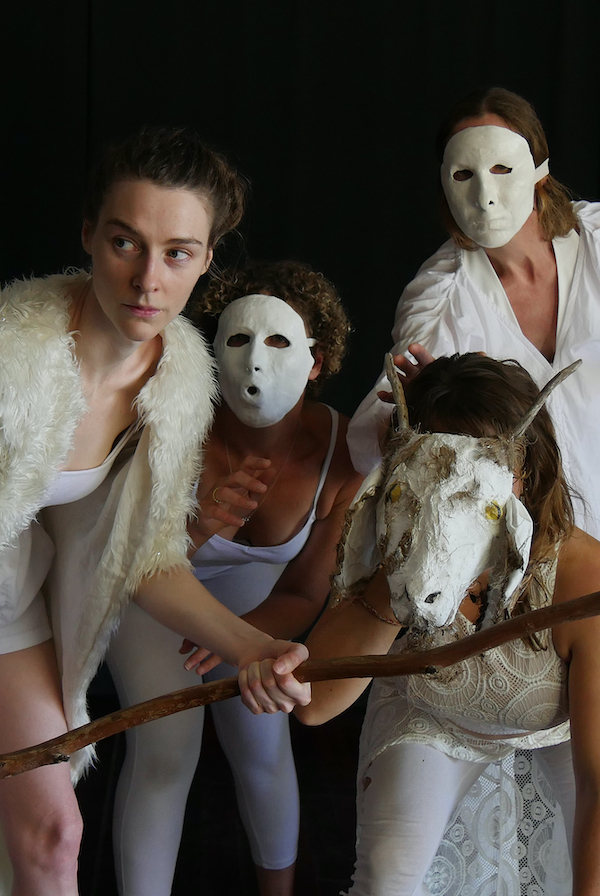For thousands of years, storytelling has helped people to cope with the unpredictable nature of human existence. This concept is at the heart of local performance company Existence Theatre, whose Fringe World 2021 work The Witch and the Goat is a timely fairy tale that reminds viewers that change cannot happen if we are driven by fear.
Facing fear through fairy tale
12 January 2021
- Reading time • 7 minutesFringe World Festival
More like this
- How to choose your Fringe World shows
- Sparkling piano bar just the tonic
- Two exhibitions too good to resist
This article is sponsored content.
Established in 2012, Existence Theatre is directed by Fremantle-based couple Bello Benischauer and Elisabeth Eitelberger. In her Fringe Session Q&A Elisabeth talks about the company and their new work, The Witch and the Goat.
Seesaw: Tell us about your work with Bello Benischauer, and Existence Theatre
Elisabeth Eitelberger: We – Bello and Elisabeth – are an artist couple, based in Fremantle. Over the past twenty years we have refined our practice by combining video projection, live sound composition, movement and text as spoken language(s), while challenging theatrical and performative methods.
We work in WA and abroad. For our Existence Theatre productions, we create temporary ensembles, depending on scope and theme and work on each project over a period of six months.
S: What can you reveal about your Fringe World 2021 show The Witch and the Goat?
EE: The Witch and the Goat is an enchanting fairy tale, definitely mesmerising and not easily forgotten! By reawakening metaphorical beings, the performers grapple with the meaning and morality of deeply rooted fears that are addressed in myths.
Bello wrote and directed the piece. It associates with typical fairy tales by critically observing gender, class and nation and is open to various interpretations about how to trust in life. This creates a lot of freedom for audience members to find their own story in what is being presented in front of their eyes. The story shows prosecutors and defendants, the dark side of people’s minds and actions but also people’s longing for a life free from bias and judgement. It asks the question: what would you wish for if you could only wish for one thing?

Moral of the story: You can’t change things if you are driven by fear and not everything can be logically explained.
The Witch and the Goat will be performed at the beautiful venue of the Old Customs House in Fremantle. Bello is performing the sound live (that he created for this piece) to the performance that is site-specifically choreographed. The story is told by the performers (Emma Benischauer, Elisabeth Eitelberger, Sarah Healy, Helah Milroy, Gala Shevtsov, Joey Valency) verbally as well as with movement and dance. Video projections fill the space, which transports the audience directly into the fairy tale and its different locations. With us the audience visits a mystical forest full of noise and the town square where people gossip and dance and have forgotten the story, while others continue to believe in every word that is told.
S: What inspired you to make The Witch and the Goat?
EE: As the name Existence Theatre suggests, all our works are about human existence; how existential questions, fears and crises affect people individually and are played out in life. The story for each production develops in the present context, reacting to what people’s concerns are in the here and now.
For thousands of years storytelling has helped people to maintain a sense of hope and respect for the unpredictable changes and blows of fate in life. By engaging with representations of good and evil, such stories approach the unknown, which stimulates interpretations about the meaning of life and its mysteries. The recent pandemic shows that even if we face the same issue, we experience it individually, because we come with different preconditions and are triggered by different things.
With this piece we again want to raise awareness that showing our personal struggling and fears is a strength and not a weakness and that there needs to be an open dialogue. Supporting each other in sharing thoughts and feelings through our stories is utterly relevant to address the fear that affects the whole society. But this cannot be done just by accusing each other of what each of us does wrong.
At the end of each performance, audience members are encouraged to stay and share their experiences and thoughts with each other, as well as with the performers, about the piece. Our productions are critical socio-cultural explorations and raise a lot of questions, and it is important to acknowledge and share the different answers that people have.
S: What is your favourite part of the playground?
EE: I think we favour the slide. It reflects a bit our projects and the outcome. There is an intense time of thoughtful preparation (climbing up the ladder), then the performance, standing on top of the slide looking down in anticipation, then sliding down with all the gathered energy (meeting with our audience) and then walking back to the ladder and climbing up again, gathering new energy, new ideas, developing new projects…
Pictured top: The cast of ‘The Witch and the Goat’ in rehearsal.
“The Fringe Sessions” is an annual series of Q&A interviews with artists who will be appearing at Fringe World. Stay tuned for more!
Seesaw offers Q&As as part of its suite of advertising and sponsored content options. For more information head to www.seesawmag.com.au/contact/advertise
Like what you're reading? Support Seesaw.






